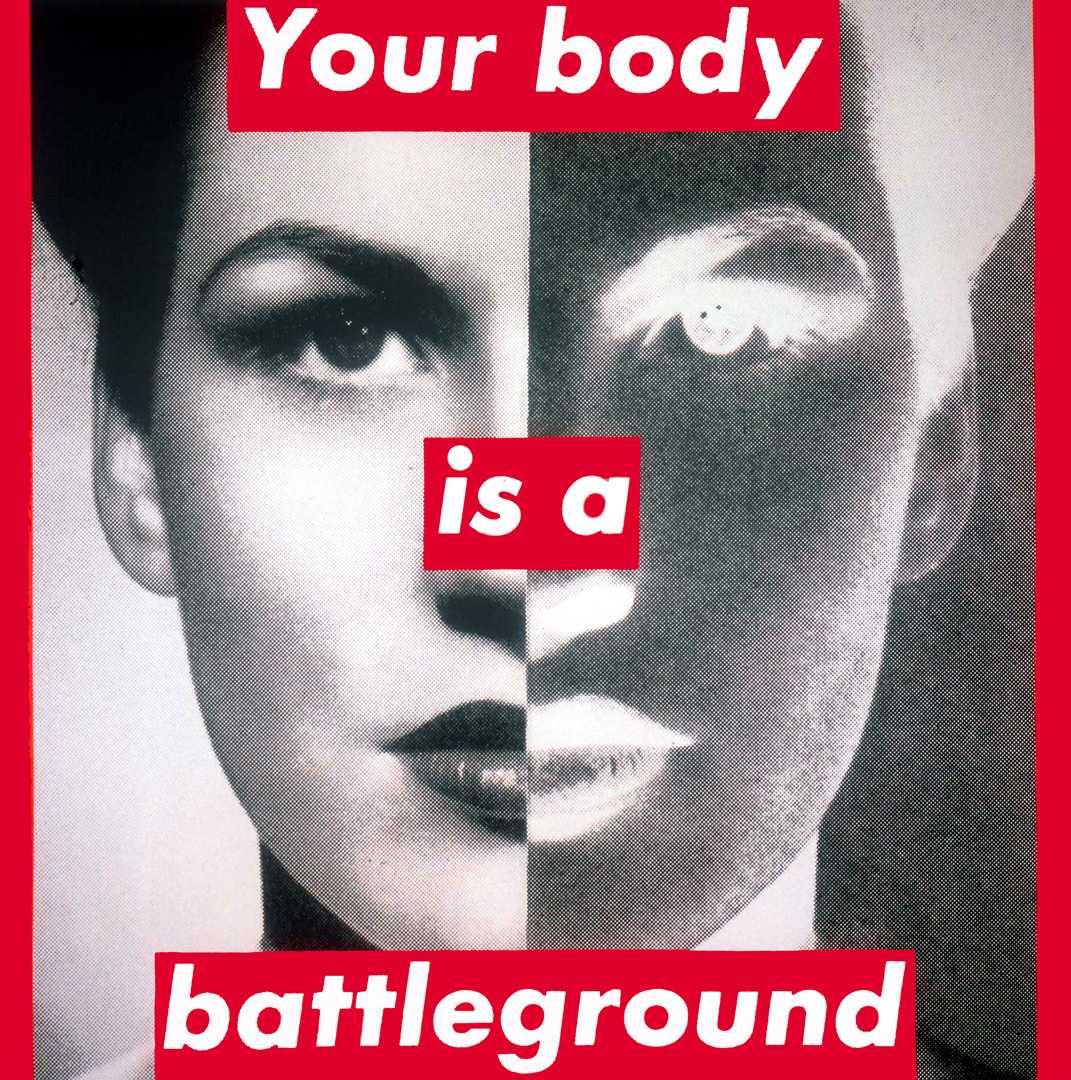
Untitled (Your body is a battleground)
KARA WALKER
The thing about audio guides is I feel inclined to tell the viewer how to, steer clear of being told how to view an artwork by somebody like me [laughs].
NARRATOR
Kara Walker.
KARA WALKER
Who is the you who’s being addressed? “Your body”. Whose body? To whom is the artist speaking? Is it you? What is the battleground? What is being fought over and why? Is it the body of a woman…?
1989 MARCH ON WASHINGTON ARCHIVAL AUDIO
Pro-choice advocates came out in force in Washington because of mounting concern that the Supreme Court may soon reverse the right to abortion...
NARRATOR
In 1989, a new wave of anti-abortion laws swept the country. That year, Barbara Kruger made Your Body is a Battleground for the historic pro-choice march in Washington D.C.
KARA WALKER
Barbara Kruger’s was one of those seminal works in this propagandistic kind of, visual style. I got very interested in the reality that artwork can have, not just the political intent but that it can actually move a crowd, you know? Spur people into action.
NARRATOR
The woman’s bisected face references the stark divide over women’s reproductive freedom.
She looks like a beauty from the ‘50s, but her face is distorted by tabloid style text, the eerie reverse image, and the disembodied head. Though she may address us with a universal “YOUR” similar to Uncle Sam’s recruiting message, this image warns us of the potential for threat rather than heroism.
KARA WALKER
An artwork confronts a viewer and a viewer is forced, asked, maybe kicked, [laughs]... into action. This work is a reminder, to me, of that very clear reality that you can’t take your life for granted.
Barbara Kruger addresses media and politics in their native tongue: tabloid, sensational, authoritative, and direct. Kruger’s words and images merge the commercial and art worlds; their critical resonance eviscerates cultural hierarchies — everyone and everything is for sale. The year 1989 was marked by numerous demonstrations protesting a new wave of antiabortion laws chipping away at the 1973 Roe v. Wade Supreme Court decision. Untitled (Your body is a battleground) was produced by Kruger for the Women’s March on Washington in support of reproductive freedom. The woman’s face, disembodied, split in positive and negative exposures, and obscured by text, marks a stark divide. This image is simultaneously art and protest. Though its origin is tied to a specific moment, the power of the work lies in the timelessness of its declaration.
Barbara Kruger was born in 1945 in Newark, New Jersey. Kruger briefly attended Syracuse University, then Parsons School of Design in New York City, where she studied with artists and photographers Marvin Israel and Diane Arbus. Kruger worked in graphic design for Condé Nast Publications at Mademoiselle magazine, and was promoted to head designer within a year, at the age of twenty-two. Kruger has described her time in graphic design as “the biggest influence on my work…[it] became, with a few adjustments, my ‘work’ as an artist.”
In the early 1970s, Kruger started showing artwork in galleries in New York. At the time, she was mainly working in weaving and painting. However, she felt that her artwork lacked meaning, and in 1976, she quit creating art entirely for a year. She took a series of teaching positions, including at University of California, Berkeley. When she began making art again in 1977, she had moved away from her earlier style into photo and text collages. In 1979, Kruger developed her signature style using large-scale black-and-white images overlaid with text. She repurposed found images, juxtaposing them with short, pithy phrases printed in Futura Bold or Helvetica Extra Bold typeface in black, white, or red text bars. In addition to creating text and photographic works, Kruger has produced video and audio works, written criticism, taught classes, curated exhibitions, designed products, such as T-shirts and mugs, and developed public projects, such as billboards, bus wraps, and architectural interventions.
Kruger addresses media and politics in their native tongue: sensational, authoritative, and direct. Personal pronouns like “you” and “I” are staples of Kruger’s practice, bringing the viewer into each piece. “Direct address has motored my work from the very beginning,” Kruger said. “I like it because it cuts through the grease.” Kruger’s work prompts us to interrogate our own positions; in the artist’s words, “to question and change the systems that contain us.” She demands that we consider how our identities are formed within culture, through representation in language and image.